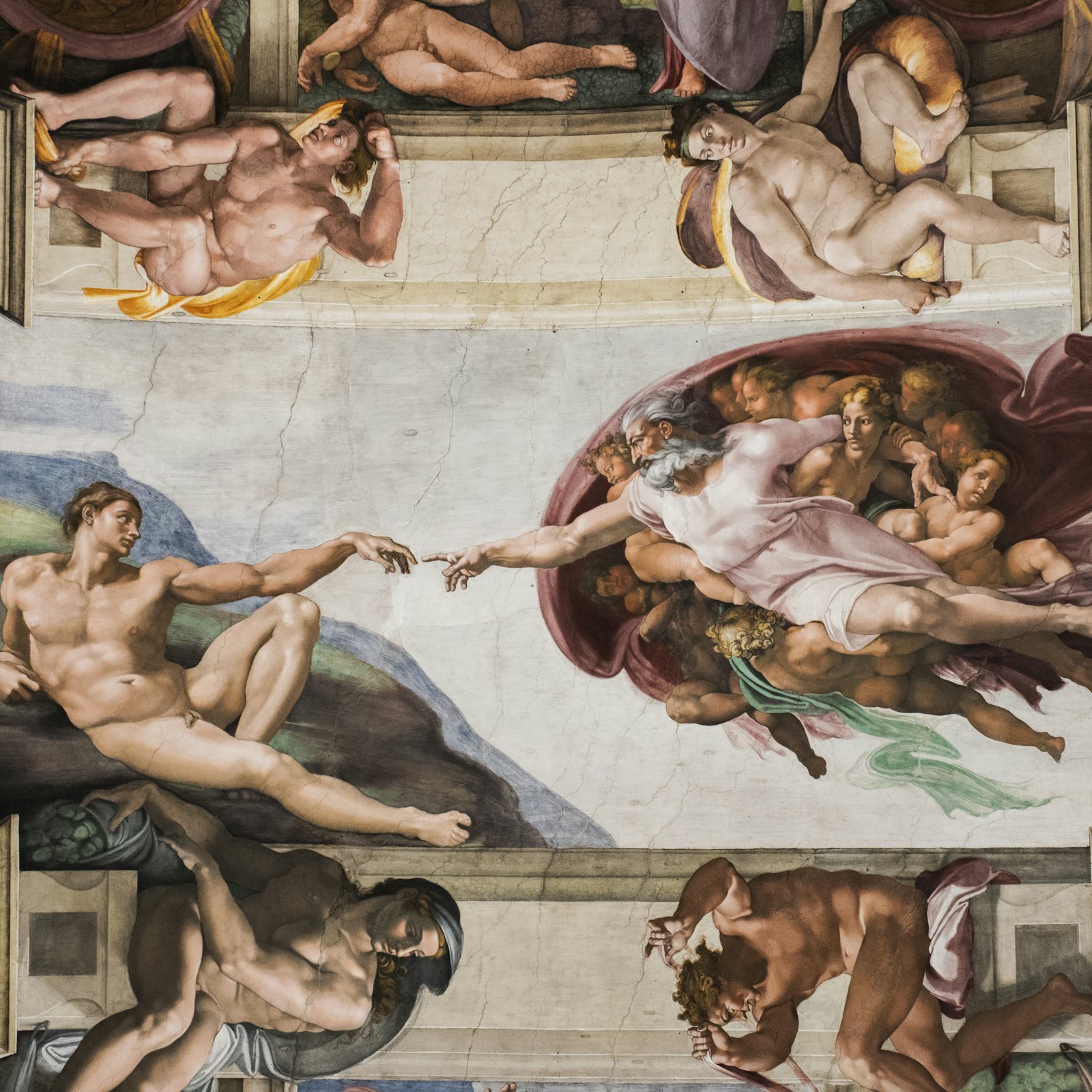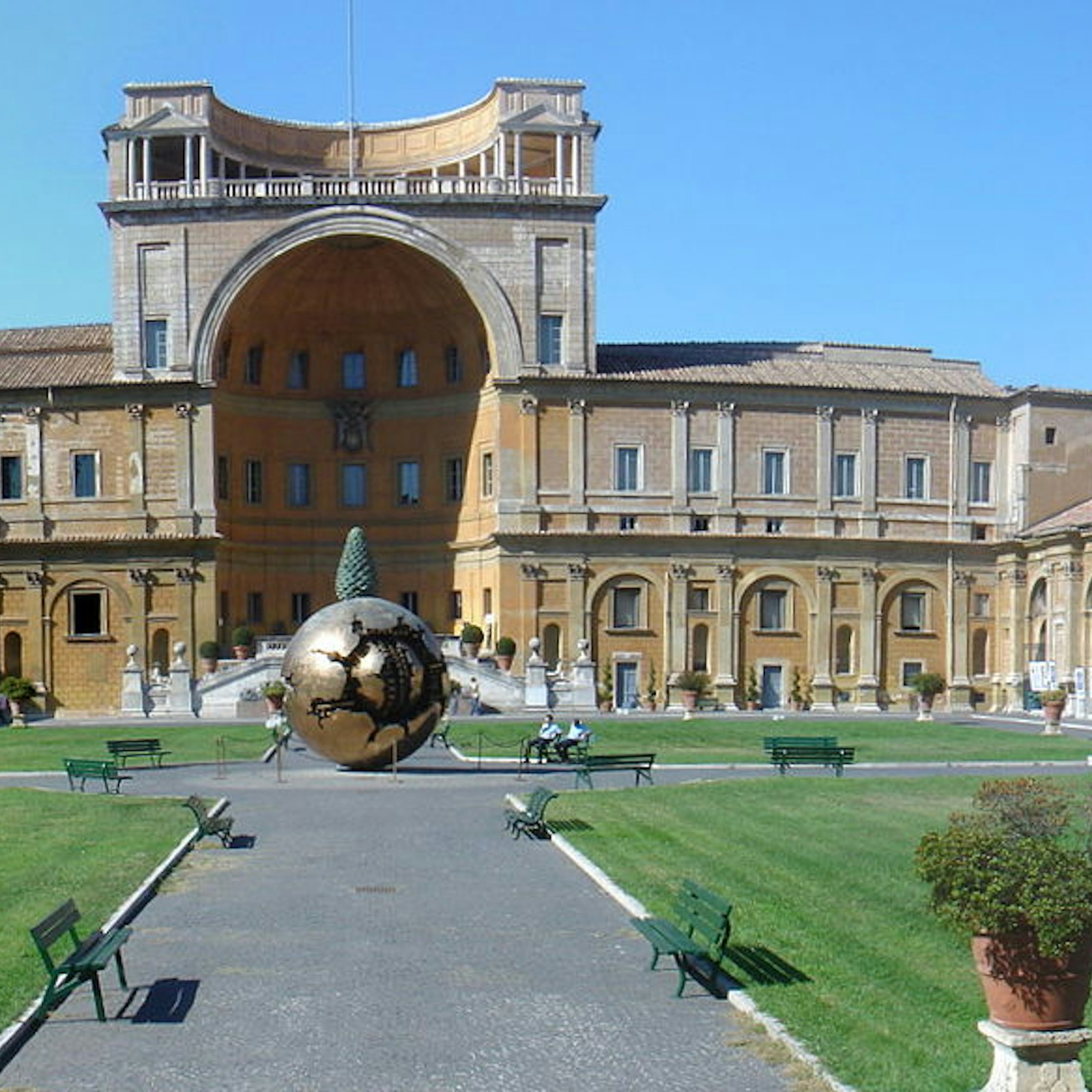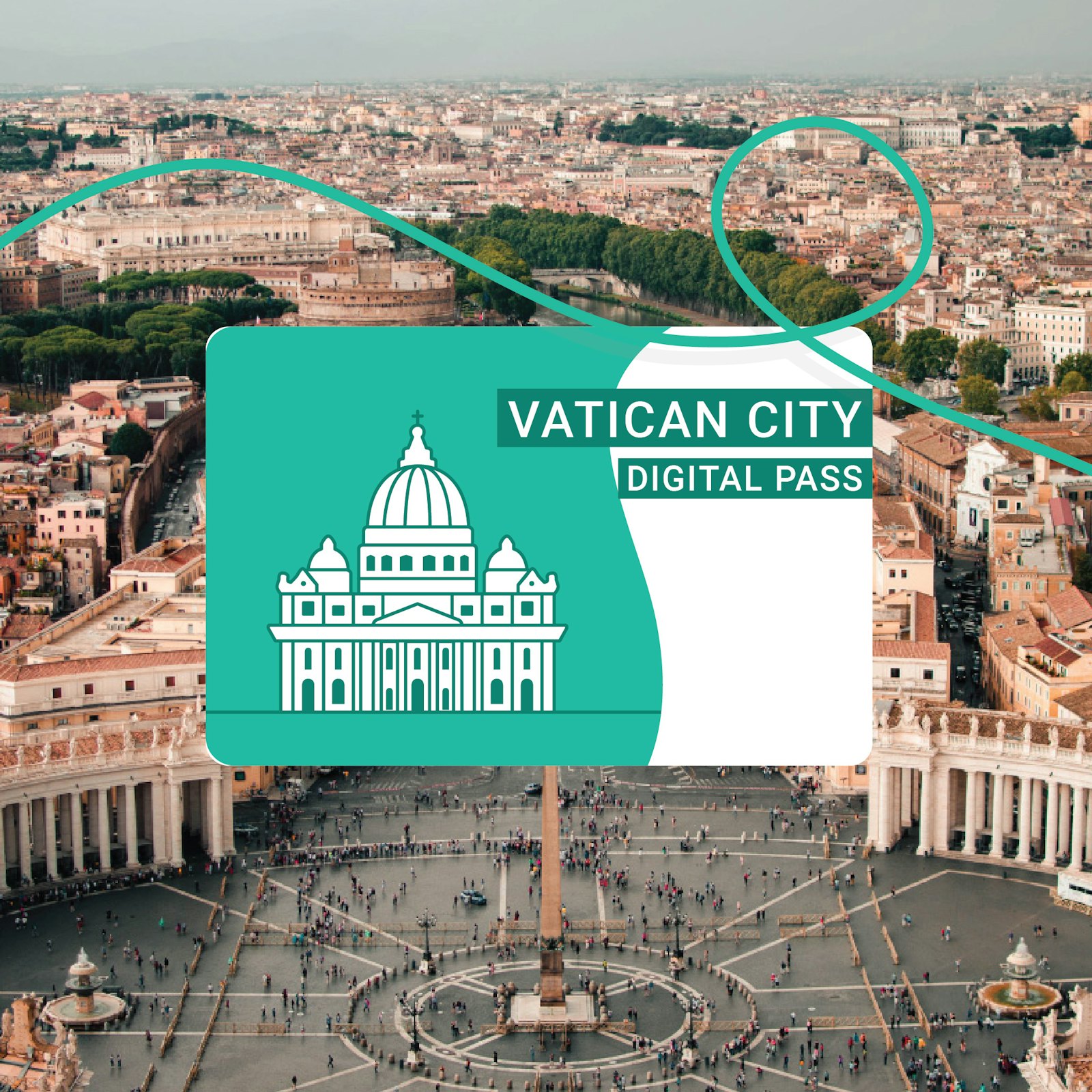Vatican Museums & Sistine Chapel: Skip The Line Entry Ticket
Michelangelo’s breathtaking frescoes and incredible artwork
- Vatican Museums: Fast Track Entry Ticket
- Sistine Chapel: Fast Track Entry Ticket

Vatican Tickets and Information
- Vatican Museums Address: Vatican City, 00120
- Opening Hours: 08:00 - 19:00
Are the Vatican Museums Worth Visiting
- If you are an art lover, absolutely.
- If you are religious, absolutely.
- If you enjoy visiting historical buildings steeped in history, absolutely.
- If you are neither of the above, its still a great place to visit, so you can say you've visited the smallest country in the world!
What You See at Vatican Museums
- Art
- Sculptures
- Religious artefacts
- Architecture
- Religious buildings
{{ticket-block-triple}}
Vatican Museums Ticket Availability
- The Vatican limits ticket numbers and they are only available online and regularly sell out, sometimes weeks and months in advance. If you know when you are visiting we suggest you book tickets as early as possible.
About The Vatican Museums & Sistine Chapel
The Vatican Museums and Sistine Chapel are in Vatican City which is the smallest country in the world! The famous landmarks are recognisable across the world and are some of Rome’s most popular tourist attractions. They offer a glimpse into centuries of human creativity through their vast and incredibly varied art and antiques collection.
The Vatican Museums were started by a series of visionary pontiffs who recognized the importance of preserving and showcasing the historical treasures that were housed in Vatican City. Notably, it was Pope Julius II who played a pivotal role in their creation as in the early 16th century, he acquired the famed ‘Laocoön’ and ‘Apollo Belvedere’ sculptures, which laid the foundation for what would become the Vatican Museums.
Over the centuries, subsequent popes continued to expand the collection with further acquisitions and then, in the 18th century, Pope Clement XIV established the ‘Pio-Clementino Museum,’ which then gave the Vatican Museums a more formalised structure.
The collection eventually outgrew its original space, which prompted the construction of additional wings and galleries, leading to what we see today and know as the Vatican Museums.
The Vatican Museums now comprises more than 20 museums, galleries, and courtyards that collectively display a huge range of art and historical artefacts. A treasure trove which naturally attracts art enthusiasts, historians, and tourists from all over the world to the point where now, especially during the peak summer months, you often have to book tickets weeks and sometimes months in advance or they sell out!
Popular Galleries at The Vatican Include:
- The ‘Pio-Clementino Museum,’
- The ‘Gallery of Maps,’
- The ‘Gregorian Egyptian Museum,’
- The ‘Raphael Rooms,’
The museums house masterpieces such as:
- Raphael's 'Transfiguration', 'The School of Athens' & 'The Annunciation'
- Caravaggio's 'The Entombment of Christ'
- Johann Wenzel Peter's 'Adam and Eve In The Garden of Eden'
- Leonardo Da Vinci's 'St. Jerome'
- As well as works by Van Gogh, Rodin, Bernini and many others.
The Sistine Chapel
A visit to the Vatican Museums isn't complete unless you see the Sistine Chapel, arguably the most famous part of the museums. Consecrated in 1483, the Sistine Chapel is arguably famous largely due to Michelangelo's art.
The ceiling frescoes which depict scenes from the Book of Genesis, and are amongst the most renowned artworks in the world. Michelangelo’s iconic fresco the "Creation of Adam," with the outstretched hands of God and Adam, being one of the biggest and most famous of all. The entire ceiling is a visual feast, with intricate details and masterful use of perspective creating a sense of depth and grandeur.
Michelangelo returned to the Sistine Chapel decades later to paint "The Last Judgement" on the altar wall. He completed it in 1541 and this monumental fresco depicts the second coming of Christ and the final judgement of souls.
While Michelangelo's frescoes may be the centrepiece, the Sistine Chapel is also home to other significant artworks. The chapel's walls are covered with works by Botticelli, Ghirlandaio, and Perugino, amongst others. Additionally, the Papal Throne adds to the chapel’s historic and cultural significance.
Pio-Clementino Museum
The Pio-Clementino Museum was starting point to the Vatican Museums, inaugurated by Pope Clement XIV in the 18th century and offers classical antiquity. Its halls are filled with sculptures that show the grandeur of ancient Greece and Rome. The collection still includes the original founding pieces being the ‘Belvedere Torso,’ the ‘Apollo Belvedere,’ and the ‘Laocoön Group,’.
The Pinacoteca
The Pinacoteca is home to a collection of around 460 paintings including masterpieces by some of the greatest artists in Italian history, including Crespi, Caravaggio, Raphael, Melozzo da Forli, Perugino, Leonardo da Vinci, Tiziano, and Veronese, amongst others. Architect Luca Beltrami was commissioned by Pius XI to create a building with optimal lighting conditions and location to ensure the preservation and display of the art. The gallery was inaugurated in October 1932.
The Gallery of Maps (La Galleria delle Carte Geografiche)
The Gallery of Maps is a must-see during your visit, in our opinion. It offers a fascinating journey through the evolution of mapmaking. Those with an interest in geography and cartography will very much enjoy the space.
Pope Gregory XIII commissioned this area in the late 16th century and the gallery has a series of topographical maps which depict Italy's regions at the time. The maps, which are all done by hand, are a testament to the skill of the Renaissance cartographers. Even though the maps were created to serve practical purposes and did represent the areas, they are also works of art in their own right. They all tell stories, not only of the landscapes but also of the political and cultural dynamics of Renaissance Italy. If you look carefully, you may even notice details such as sea monsters and other mythological figures! You don't find that on most maps of today!
Raphael Rooms
Named after the famous Renaissance artist Raphael, the 'Raphael Rooms', or the ‘Stanze di Raffaello,’ are a collection of four interconnected rooms that are filled with frescoes showing the pinnacle of Renaissance art. Raphael, along with his workshop, created the masterpieces between 1508 and 1524.
One of the most significant pieces in the Raphael Rooms is “The School of Athens” which is in the 'Room of the Segnatura'. The piece portrays the intellectual spirit of the Renaissance period featuring a group of intellectuals including philosophers, scientists, and scholars from different historical periods. The central figures are Plato and Aristotle, who appear to be in deep contemplation and they are surrounded by other luminaries such as Socrates, Euclid, and Ptolemy. It would have been very interesting to have been there for that conversation! If you view the works in the rooms in chronological order you can actually see how Raphael's style changed over time.
The Vatican Museums consist of:
Gregorian Egyptian Museum
- Museum Focus: Ancient Egyptian artifacts.
- Highlights: Statues, mummies, papyri, sarcophagi, and items related to Egyptian religion and daily life.
Pio Clementino Museum
- Museum Focus: Classical antiquities, particularly Greek and Roman sculptures.
- Highlights: Famous pieces such as Laocoön and His Sons, Apollo Belvedere, and the Belvedere Torso.
Pius-Christian Museum
- Museum Focus: Early Christian art and artifacts.
- Highlights: Sarcophagi with biblical scenes, mosaics, and inscriptions.
Lapidario Profano ex Lateranense
- Museum Focus: Secular (profane) inscriptions and sculptures from ancient Rome.
- Highlights: Inscriptions, reliefs, and architectural fragments.
Christian Lapidarium
- Museum Focus: Christian inscriptions and epitaphs.
- Highlights: Early Christian tombstones, epitaphs, and symbols.
Carriage Pavilion
- Museum Focus: Papal carriages and vehicles.
- Highlights: Historical carriages, automobiles, and sedan chairs used by popes.
Profane Museum
- Museum Focus: Artifacts from the classical world unrelated to religious themes.
- Highlights: Greek and Roman bronzes, ceramics, and minor arts.
Chapel of St. Peter Martyr
- Museum Focus: Chapel with religious art and decoration.
- Highlights: Frescoes and devotional works related to St. Peter Martyr.
Ethnological Museum
- Museum Focus: Artifacts from cultures around the world.
- Highlights: Objects representing global religious traditions and cultures, gifted to the Vatican.
Niccoline Chapel
- Museum Focus: Renaissance frescoes.
- Highlights: Frescoes by Fra Angelico, depicting the lives of St. Stephen and St. Lawrence.
Room of the Immaculate Conception
- Museum Focus: Celebration of the dogma of the Immaculate Conception.
- Highlights: Frescoes by Francesco Podesti.
Gregorian Etruscan Museum
- Museum Focus: Etruscan civilization artifacts.
- Highlights: Tomb goods, bronzes, ceramics, and the famous Mars of Todi statue.
Chapel of Urban VIII
- Museum Focus: Religious art from the Baroque period.
- Highlights: Decorations and art commissioned by Pope Urban VIII.
Room of the Chiaroscuri
- Museum Focus: Renaissance art emphasizing chiaroscuro technique.
- Highlights: Frescoes with dramatic contrasts of light and shadow.
Borgia Apartment
- Museum Focus: Renaissance art and papal history.
- Highlights: Frescoes by Pinturicchio, commissioned by Pope Alexander VI.
Lapidary Gallery
- Museum Focus: Inscribed stone slabs and sculptures.
- Highlights: Roman, Etruscan, and early Christian inscriptions.
Gregoriano Profano Museum
- Museum Focus: Classical Roman and Greek antiquities.
- Highlights: Statues, mosaics, and objects of daily life.
Pinacoteca
- Museum Focus: Paintings from the 12th to the 19th century.
- Highlights: Works by Raphael, Caravaggio, Leonardo da Vinci, and other great masters.
Sistine Chapel
- Museum Focus: Frescoes by Renaissance artists.
- Highlights: Michelangelo's Ceiling Frescoes and The Last Judgment.
Raphael's Rooms
- Museum Focus: Renaissance frescoes.
- Highlights: Raphael's School of Athens and other masterpieces.
Chiaramonti Museum
- Museum Focus: Ancient sculptures and inscriptions.
- Highlights: Portrait busts, statues, and Roman reliefs.
New Wing (Braccio Nuovo)
- Museum Focus: Classical Roman sculptures.
- Highlights: Augustus of Prima Porta, Doryphoros, and other significant statues.
Room of the Aldobrandini Wedding
- Museum Focus: Frescoes and artifacts from the Roman period.
- Highlights: The Aldobrandini Wedding fresco, depicting a Roman wedding scene.
Christian Museum
- Museum Focus: Christian art and artifacts.
- Highlights: Early Christian mosaics, icons, and liturgical items.
Jewish Lapidarium
- Museum Focus: Jewish inscriptions and artifacts.
- Highlights: Tomb inscriptions and artifacts from the Jewish diaspora in Rome.
Collection of Modern and Contemporary Art
- Focus: Modern religious art.
- Highlights: Works by artists like Matisse, Chagall, and Dalí, among others.
Popular Tickets
Popular Attractions
Vatican FAQs
- What are the main attractions in Vatican City?
- The Vatican's main attractions include St. Peter's Basilica, the Vatican Museums, the Sistine Chapel, and St. Peter's Square.
- What is the best time to visit the Vatican?
- The best time to visit the Vatican is early in the morning, right when it opens, or later in the afternoon, if you would prefer to avoid the largest crowds. Weekdays are generally less crowded than weekends. Visiting in the off-season (November to February) can also mean fewer tourists. No matter when you plan to visit, we always suggest booking tickets online before you go to guarantee your entry. Click HERE for ticket options.
- Do I need to buy tickets in advance for the Vatican Museums?
- Yes, it’s highly recommended to buy tickets for the Vatican Museums and Sistine Chapel in advance to skip the long lines and also to guarantee your entry as tickets regularly sell out, especially during peak season.
- Is there a dress code to visit the Vatican?
- Yes, there is a strict dress code. Shoulders and knees must be covered for both men and women. Low-cut or sleeveless tops, shorts, and skirts above the knee are not allowed, especially when entering religious spaces like St. Peter's Basilica. Please remember it may be a tourist attraction but it is also a religious location.
- Can I take photos inside the Vatican Museums and the Sistine Chapel?
- Photography is allowed in most areas of the Vatican Museums, but it is strictly forbidden inside the Sistine Chapel. Flash photography is also prohibited in certain areas to protect the artwork.
- How long does a visit to the Vatican typically take?
- A thorough visit to the Vatican Museums and Sistine Chapel can take around 3 to 4 hours. If you also plan to visit St. Peter's Basilica and the dome, expect to spend around 5 to 6 hours.
- How can I attend a Papal Audience or Mass with the Pope?
- Click HERE for ticket details.
- Is the Vatican accessible for people with disabilities?
- Yes, the Vatican Museums offer routes that are wheelchair accessible, and there are elevators available for disabled visitors. St. Peter's Basilica is also accessible, although some areas, like the dome, may be difficult to reach.
- Can I climb to the top of St. Peter's Basilica dome?
- Yes, visitors can climb to the top of the dome for a panoramic view of Rome and Vatican City. Click HERE for ticket details.
Vatican City Fun Facts
- Size Matters: Vatican is the smallest country in the world and only became an independent country in 1929!
- Latin: The Vatican is the only country in the world to have a cash machine with JUST Latin instructions on it!
- Goal: The Vatican has its own football team!
- Residency: The Vatican has less than 1000 residents!
- UNESCO: The Vatican is a UNESCO World Heritage Site.
- Criminal: The Vatican is the only country on earth not to have its own prison!
- Thirsty Work: Its suggested the Vatican consumes more wine than any other country in the world (on a per capita basis)!
- Tickets Please: The Vatican is home to the shortest railway line in the world!
- Size Matters (again): St Peter's Basilica, located in the Vatican is one of the largest churches in the world!
- Money Talks: Although the euro is the official currency used in the Vatican, it does still have its own currency (the Vatican lira) and it's still used for ceremonial purposes! However, you can still spend Euros there too!
- Travelling: The St. Peter's Square Obelisk (the tall stone pillar) was actually originally built in Egypt, however it was moved to Rome by Emperor Caligula and was eventually placed in St. Peter's Square by Pope Sixtus V in 1586!
- Looking up to Heaven: The Vatican has its own observatory, known as the Vatican Observatory, which conducts astronomical research and is one of the oldest astronomical research institutions in the world.
- Size Matters (again!): The Swiss Guard is the smallest and oldest standing army in the world, responsible for the security of the Vatican. Their distinctive uniforms, designed by Michelangelo, make them easily recognizable.
- Landscaping: The Vatican Gardens cover more than half of the Vatican City's territory. They are private and can only be visited on guided tours.
- A Work of Art: The dome of St. Peter's Basilica, designed by Michelangelo, is one of the largest domes in the world. It offers panoramic views of Rome and the Vatican City.
- Bilingual: Latin is the official language of the Vatican, but Italian is commonly used for everyday communication.
Useful Information About Vatican Museums & Sistine Chapel
Tips for Visiting
- Book Tickets Online: If you know when you are visiting the city, we strongly suggest booking tickets online in advance. The Vatican Museums and Sistine Chapel regularly sell out weeks and sometimes months in advance, especially during peak season, so booking in advance gives you more chance of booking the time that works for you.
- Dress Appropriately: Please remember it is a religious building, so you are asked to dress appropriately.
- Combination Ticket: Consider a combination ticket to enjoy more attractions! Click HERE to see Vatican combination ticket options.
Vatican Museums and Sistine Chapel Address
- Vatican Museums, Vatican City, 00120
How to get to the Vatican Museums
- By Bus: Number 49 to Viale Vaticano
- By Metro: Line A to Valle Aurelia, then a 5-minute walk
- By Tram: Number 19 to Piazza del Risorgimento, then a 10-minute walk
Vatican Museums and Sistine Chapel Opening Hours
- Monday 09:00 - 18:00
- Tuesday: 09:00 - 18:00
- Wednesday 09:00 - 18:00
- Thursday 09:00 - 18:00
- Friday 09:00 - 18:00
- Saturday 09:00 - 22:30
- Sunday: Closed





























